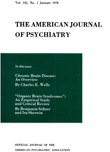The prediction of dangerous behavior in emergency civil committment
Abstract
The authors compared the records of 59 psychiatric patients involutarily committed to a Veterans Administration hospital on an emergency basis with those of a control group of 59 psychiatric patients with respect to the number of assaults noted during the first 45 days of hospitalization. The committed group had a .41 probability and the control group a .08 probability of committing an assault. The difference between the two groups was mainly accounted for by assaults that occurred during the first 10 days of hospitalization. The occurrence of an actual act of battery before admission did not predict assault in the hospital to a greater degree than did a verbal threat. The authors conclude that short-term clinical predictions of dangerousness predict assaultiveness in the hospital to a significant degree.
Access content
To read the fulltext, please use one of the options below to sign in or purchase access.- Personal login
- Institutional Login
- Sign in via OpenAthens
- Register for access
-
Please login/register if you wish to pair your device and check access availability.
Not a subscriber?
PsychiatryOnline subscription options offer access to the DSM-5 library, books, journals, CME, and patient resources. This all-in-one virtual library provides psychiatrists and mental health professionals with key resources for diagnosis, treatment, research, and professional development.
Need more help? PsychiatryOnline Customer Service may be reached by emailing [email protected] or by calling 800-368-5777 (in the U.S.) or 703-907-7322 (outside the U.S.).



